You’ve likely looked up at the night sky, wondering about the Big Dipper and Little Dipper.
Yet, their elusive nature might have frustrated you in your attempts to spot them.
In a nutshell:
- The Little Dipper and Big Dipper are essential star patterns in the night sky
- Both the Little and Big Dipper are part of more prominent constellations, representing bears in mythology
- The Big Dipper asterism is beneficial for navigating and observing other celestial objects
I’m here to guide you, offering tips and insights to help you easily locate and appreciate the Big Dipper and Little Dipper, and much more to enhance your stargazing adventures.
Let’s dive right in.
Recommended For You
Big Dipper Little Dipper Basics
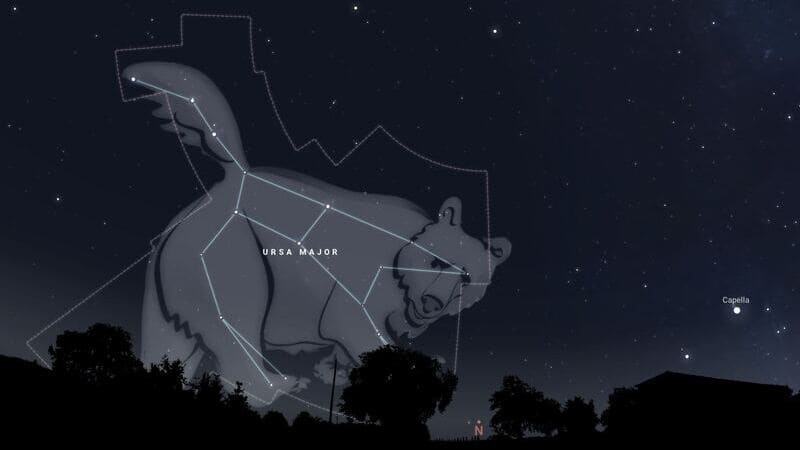
What are the key features of the Big Dipper vs Little Dipper?
The Big Dipper boasts seven bright stars forming a ladle shape, while the Little Dipper is smaller and contains Polaris, the North Star, at its tip. By identifying these patterns, you’ll navigate the night sky with ease.
Hey, stargazers! Ready to learn about the Big and Little Dipper?
These two famous star patterns, or asterisms, can be seen high in the northern sky from the Northern Hemisphere. They’re part of larger constellations: the Big Dipper belongs to Ursa Major, and the Little Dipper to Ursa Minor. Read more in my article about the Big Dipper vs Ursa Major.
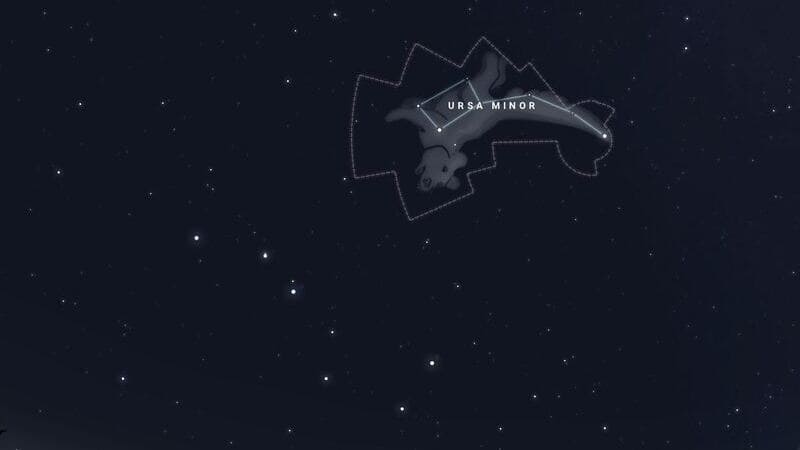
In the Big Dipper, you can find seven bright stars. They form a pattern that resembles a ladle or a large dipping spoon. Dubhe, Merak, Phecda, and Megrez make up the bowl, while Alioth, Mizar, and Alkaid form the handle.
What does the Little Dipper look like? And where is the Little Dipper?
Similarly, the Little Dipper has seven stars but is smaller and less bright, making it slightly trickier to spot. Polaris, the famous North Star, marks the tip of the Little Dipper’s handle.
To locate the dippers, first search for the Big Dipper. Once you’ve found it, use the two outer stars in the bowl (Dubhe and Merak) as pointers to lead you to Polaris. The Little Dipper will then reveal itself around Polaris. Remember these simple steps:
- Locate the Big Dipper, the bigger constellation.
- Identify Dubhe and Merak.
- Follow the line they create to find Polaris.
- Polaris marks the tip of the Little Dipper’s handle.
Here’s some fun info to help make the dippers even more relatable:
- Big Dipper is like a giant soup spoon, while Little Dipper is like a small dessert spoon.
- Think of the dipper handles as the tails of two celestial bears since Ursa Major and Ursa Minor mean “Greater Bear” and “Lesser Bear,” respectively.
As a stargazer, keep your eyes peeled for the dippers and enjoy their beauty. Remember these tips, and you’ll soon be able to locate them quickly.
Can you see the Big Dipper and Little Dipper at the same time?
Yes, you can see the Big Dipper and the Little Dipper at the same time. These two constellations are often visible in the night sky in the northern hemisphere, with the Big Dipper being more prominent. Depending on your location and the time of year, they may appear in different parts of the sky, but you can usually observe them during a single night of stargazing.
The big dipper constellation Key Stars and Components

Which stars and components are essential to the Big Dipper and Little Dipper?
In the Big Dipper, you’ll find stars like Dubhe, Merak, and Alioth, while the Little Dipper features Polaris and stars like Kochab and Pherkad. These key celestial elements serve as your guides to these iconic constellations.
The Big Dipper and Little Dipper are easily recognizable patterns in the night sky. To make sense of these star formations, let’s look at their key components:
- Big Dipper: An asterism, a group of stars forming a recognizable pattern within the Ursa Major constellation.
- Little Dipper: Another asterism found within the Ursa Minor constellation.
One tip to find the Little Dipper is to use the two outer stars in the bowl of the Big Dipper, called pointers. They are:
- Merak
- Dubhe
Follow the line created by these pointers, and you’ll reach the brightest star in the Little Dipper: Polaris, also known as the North Star. This might help you:
- Merak + Dubhe → Polaris
In the bowl of the Little Dipper, you’ll find two important stars, Kochab and Pherkad. They also form part of the constellation Ursa Minor.
Now, let’s break down the stars in the handle and bowl of the Big Dipper. Seven stars make up this well-known asterism, some with picturesque names:
- Handle: Alkaid, Mizar, and Alioth
- Bowl: Megrez, Phecda, Merak, and Dubhe
Mizar, in particular, is a fascinating star. When you closely observe it, there’s a dimmer star beside Mizar called Alcor. They are often referred to as the “Horse and Rider” duo.
So, when gazing up at the night sky, remember these key stars and components to point out the Big Dipper and Little Dipper confidently.
FREE STARGAZING CHECKLIST
My 5-page Stargazing Checklist will enhance your astronomical observations.
Follow this free checklist to navigate the night sky with confidence, clarity, and a sense of preparedness for a rewarding stargazing experience.

Locations and Visibility
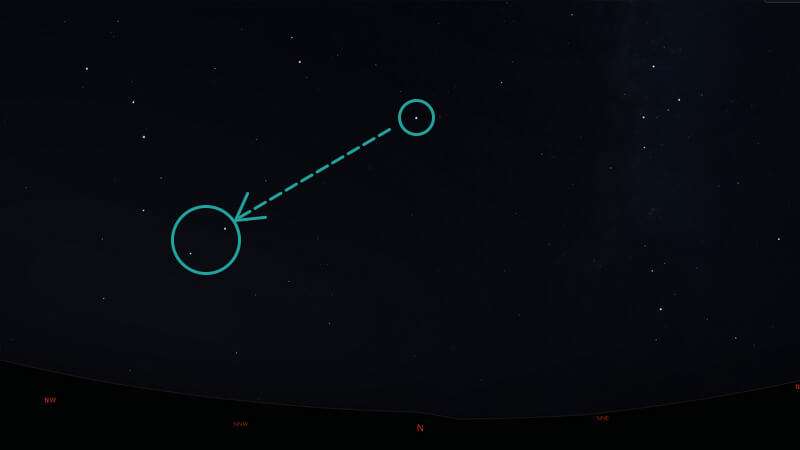
You can easily spot the Little Dipper and Big Dipper from North America high in the sky during spring evenings. To find them, first look for the two outer stars in the bowl of the Big Dipper, which point towards Polaris, the North Star.
Do you know if you can see the Big Dipper all year round?
Polaris is part of the Little Dipper, so once you’ve found it, you’ve located the entire Little Dipper. These two-star patterns are considered circumpolar, meaning they’re always visible in the sky throughout the year, as long as your latitude is high enough in the Northern Hemisphere. If you’re in the Southern Hemisphere, unfortunately, you won’t be able to see them.
Do you know if everyone on Earth can see the Big Dipper?
Some fascinating facts about these star patterns:
- The position of the North Celestial Pole changes over time due to precession: a slow, circular motion of Earth’s axis.
- The North Pole of our planet points relatively close to Polaris, making it the North Star.
Here are a few tips to help you locate these patterns:
- Head outside on a clear night, preferably away from city lights.
- First, find the Big Dipper by looking for its distinct “bowl-and-handle” shape.
- Follow the two outer stars in the bowl toward Polaris, and you’ll discover the Little Dipper.
You’re ready to impress your friends or family with your newfound stargazing skills! Quick, grab a blanket and some hot cocoa, and head out for a night of sky-watching fun.
Connection to Constellations and Asterisms
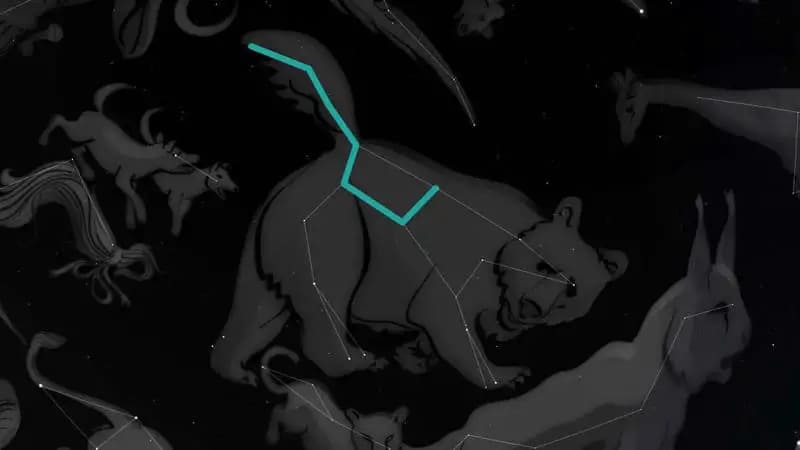
Constellations like Ursa Major and Ursa Minor may catch your eye when you gaze at the night sky. Within these constellations, you’ll find familiar asterisms such as the Big Dipper and the Little Dipper. To make your stargazing experience even better, let’s explore how these asterisms relate to the constellations they belong to.
The Big Dipper is an asterism composed of seven bright stars within the Ursa Major constellation. You might also know it as the Plough, the Great Wagon, or the Saucepan. It’s easily recognized because of its distinct shape, which resembles a ladle or “dipper.” The two outer stars of the Big Dipper’s bowl, Dubhe and Merak, are called pointers because they point towards Polaris, the North Star. Polaris is located in the Ursa Minor constellation, which also hosts the Little Dipper‘s star pattern.
Ursa Major, or the Great Bear, and Ursa Minor, the Little Bear, are constellations of the more prominent Ursa Major family. Apart from the Dippers, there are other fascinating celestial formations within this family, like Draco, the Celestial Dragon, which winds its way around Ursa Major and Ursa Minor.
Here are some key points to remember:
- Constellations are official patterns of stars, while asterisms are recognizable yet unofficial star formations.
- Big Dipper vs Little Dipper? The Big Dipper is in Ursa Major, and the Little Dipper is in Ursa Minor.
- Ursa Major and Ursa Minor, including Draco, are part of the Ursa Major family.
Another example of an asterism is the Northern Cross. This star pattern can be found within the constellation Cygnus. Like the Big and Little Dipper, the Northern Cross is an easily recognized shape in the night sky.
During your stargazing adventures, you’ll find that understanding the connections between constellations and asterisms will enhance your appreciation for the beauty and wonder of the cosmos. So grab your telescope or binoculars, and venture out on a clear night to spot these celestial patterns.
Astronomical Significance
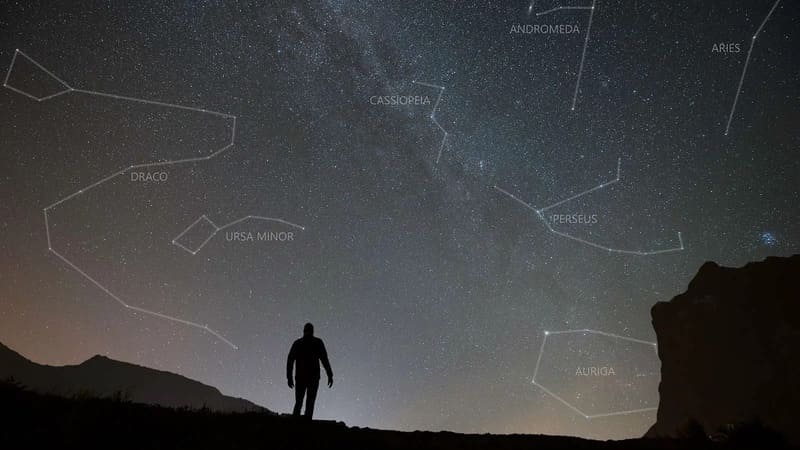
In astronomy, the Little Dipper and Big Dipper are important constellations with many uses. People have relied on these star patterns for navigation and storytelling for centuries. Let’s dive into their significance and how they relate to other constellations.
The Big and Little Dipper are part of the “Guardians of the Pole” group due to their proximity to the North Star, Polaris. Being close to Polaris, they’ve been navigation tools for generations. To find Polaris, you must follow the two outer stars of the Big Dipper’s bowl in a straight line. Once you find Polaris, you’ve pinpointed true north, making your travels much easier.
Here’s a quick comparison of the two Dippers:
- Size: The Big Dipper is larger, as its name suggests, while the Little Dipper is smaller and fainter.
- Constellation: The Big Dipper is part of Ursa Major (the Great Bear), and the Little Dipper is part of Ursa Minor (the Lesser Bear).
Other constellations surrounding the Big and Little Dipper include:
- Draco the Dragon, which winds around the North Star.
- Virgo, a constellation related to Arcturus, is a bright star found following the arc of the Big Dipper’s handle.
Aside from Draco and Virgo, the Big Dipper can also guide you to other fascinating constellations like Coma Berenices, Canes Venatici, Lynx, Leo, and Leo Minor. To find these constellations, do the following:
- Coma Berenices: Find the kite-shaped constellation by drawing an imaginary line from the Big Dipper’s handle to Arcturus and continuing to Spica.
- Canes Venatici: Look below the Big Dipper’s handle.
- Lynx, Leo, and Leo Minor: Extend a line from the two inner stars of the Big Dipper’s bowl. These constellations lie along that path.
So, as you venture into the night sky, remember to watch for the Big and Little Dipper. They’ll guide you through the cosmos and connect you to a long tradition of astronomical exploration.
Light and Distance
Let’s talk about their brightness and distance from us.
As seen from Earth, the star’s brightness is called its apparent magnitude. Lower numbers indicate brighter stars and higher numbers indicate dimmer stars.
In the Big Dipper:
- Dubhe: 1.79 magnitude
- Merak: 2.37 magnitude
- Phecda: 2.44 magnitude
In the Little Dipper:
- Polaris (North Star): 1.97 magnitude
- Kochab: 2.07 magnitude
Notice that Polaris is almost as bright as Dubhe, even though it’s much farther away. This is because Polaris is more luminous (gives off more light) than Dubhe.
Now let’s talk about distances. Stars are so far away that we measure light-year distances (how far light travels in one year). Here are some distances from Earth to the stars in the Big and Little Dipper:
- Polaris: 323 light-years
- Dubhe: 123 light-years
- Merak: 79.7 light-years
- Kochab: 130 light-years
I wrote a whole separate article about how far away the Big Dipper is.
When you look at the Big Dipper and Little Dipper, remember:
- The stars’ brightness depends on their apparent magnitude and how luminous they are
- The stars are incredibly distant, with Polaris being the farthest at 323 light-years away!
Imagine gazing into the night sky, with the Big Dipper’s bright Dubhe and Merak pointing towards the distant yet luminous Polaris. Enjoy the cosmos’ wonder as you confidently identify these easily recognizable constellations!
Cultural and Historical Influence
The Big Dipper and Little Dipper have influenced cultures throughout history, often used as navigation tools and symbols in myths and legends. For instance, Native American tribes saw the Big Dipper as a Great Bear, while Europeans saw it as a Great Wagon or a Saucepan.
Just think of the clever Drinking Gourd, a name often used for the Big Dipper. This formation guided enslaved people in the United States to freedom by helping them locate the North Star, which led them northward.
Now, let’s dive into the stories and history involving these famous star formations:
- Greek astronomers: Ancient Greeks dedicated the Big Dipper to the myth of Callisto, a nymph who turned into a bear and lived among the stars as the Ursa Major constellation.
- Saptarishi: In Hindu traditions, the Big Dipper represents the Seven Wise Men of the Vedas and symbolizes the soul’s pathway.
Observing the Big Dipper and Little Dipper
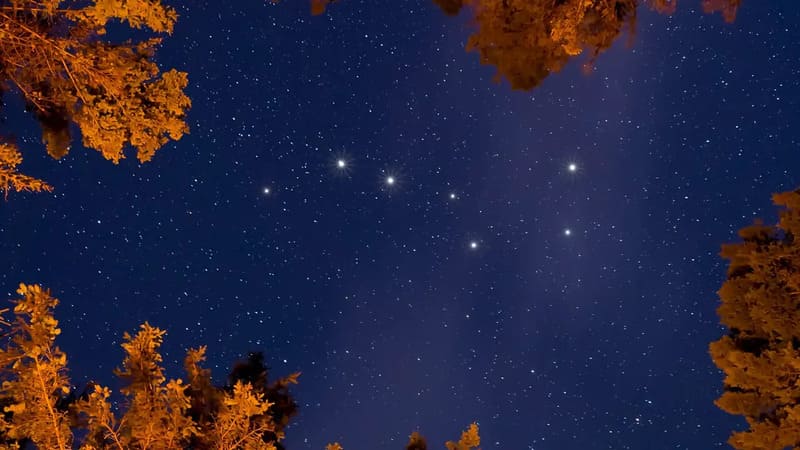
The Big Dipper is one of the easiest constellations to spot when gazing at the night sky. It comprises seven bright stars visible from +90° to -30° latitude. The best time to see it is in April at 9 p.m. To find the Little Dipper, use the two outer stars in the bowl of the Big Dipper to locate Polaris, the North Star, which marks the end of the Little Dipper’s handle.
Here are some quick tips for spotting these famous star patterns:
- Find a dark location with minimal light pollution.
- Let your eyes adjust to the darkness for at least 10 minutes.
- Look for the Big Dipper in the northern sky, high above the horizon.
- Use the outer stars in the Big Dipper’s bowl to locate the Little Dipper.
Remember that both dippers can look different depending on how you view them. The Big Dipper might appear as if it’s upside down or sideways. The same goes for the Little Dipper. Like trying to spot a hidden picture in a jigsaw puzzle, once you “see” these constellations, you won’t be able to unsee them, and observing them in the future will become easier.
Now, let’s add some fun facts to impress your friends or fellow stargazers:
- Six Big Dipper stars are of magnitude 2, while Megrez is of magnitude 3.
- The stars that form the Little Dipper are not as bright as those in the Big Dipper, making it a slightly more challenging constellation to spot.
Connections to Other Entities
You might be surprised to learn that the Big Dipper and Little Dipper have interesting connections to other constellations and star names. Here are some other fascinating entities related to the Big Dipper and Little Dipper:
- Ahfa al Farkadain: This star is part of the Little Bear (Ursa Minor) constellation. It represents the southern “guard” of the North celestial pole.
- Yildun: Another star in the Ursa Minor constellation, Yildun, sits very close to the North celestial pole, making it a reliable point of reference in the sky.
- Little Bear: This is another common name for the Ursa Minor constellation, which contains the Little Dipper asterism.
To brush up on your amateur astronomy skills, keep these tips in mind when observing the night sky:
- Take time to locate the Big Dipper and Little Dipper in the sky.
- Use the Big Dipper’s outer bowl stars to find Polaris.
- Look for other constellations like Ursa Major and Ursa Minor, and become familiar with their star patterns.
Remember, amateur astronomy can be a fun and engaging hobby. Don’t be afraid to practice and explore the night sky – you might discover a newfound appreciation for the cosmos!
Frequently Asked Questions
Where can I find the Big Dipper and Little Dipper tonight?
To find the Big and Little Dipper tonight, look for them high in the northern sky on spring evenings. If you’re in the Northern Hemisphere, you can use the two outer stars in the bowl of the Big Dipper to locate Polaris, the North Star, which marks the end of the handle of the Little Dipper. Remember that their exact positions in the sky might vary nightly.
What is the significance of the Big Dipper and Little Dipper?
The Big Dipper and Little Dipper are important because they are among the most recognizable asterisms in the night sky. These asterisms have guided people for centuries, helping them to navigate and tell time at night. For example, using the Big Dipper, you can easily find the North Star, which stays relatively fixed in the sky and has been an essential point of reference for travelers and sailors throughout history.
Are the Big Dipper and Little Dipper visible at the same time?
Yes, the Big Dipper and Little Dipper can be visible simultaneously, especially in the Northern Hemisphere. Since both asterisms are pretty close to each other, they often appear in the same part of the sky. Remember that their visibility might change depending on the time of year and your location.
What is the relationship between the Big and Little Dipper?
The Big Dipper and Little Dipper are connected through their proximity in the night sky and their shared resemblance to a kitchen ladle, or “dipper.” The Big Dipper is also part of the Ursa Major constellation, while the Little Dipper is part of the Ursa Minor constellation. These two similar shapes close together in the sky are intriguing and have captured people’s imaginations throughout history.
How can I differentiate between the Big Dipper and Little Dipper?
Distinguishing between the Big Dipper and Little Dipper can be pretty simple once you know their positions in the sky and shapes. The Big Dipper is more extensive and typically more prominent, while the Little Dipper is smaller and fainter. If you locate the two outer stars in the bowl of the Big Dipper and use them to find Polaris, the North Star, you can trace out the shape of the Little Dipper from there.
What are the official names of the Big and Little Dipper constellations?
The official names of the constellations that include the Big Dipper and Little Dipper are Ursa Major and Ursa Minor, respectively. While the dippers are asterisms and not actual constellations, they still play a crucial role in locating their more prominent constellations. Ursa Major is the third-largest constellation in the sky, whereas Ursa Minor is much smaller, just like their corresponding dippers.
where is the little dipper in relation to the big dipper?
The Little Dipper is located near the Big Dipper in the night sky. It’s positioned in such a way that it appears to rotate around the North Star, Polaris, which is at the end of the handle of the Little Dipper. If you imagine the Big Dipper as a clock face, the Little Dipper is like the hour hand, with Polaris being very close to the center of the clock. So, in the northern hemisphere, you can often find the Little Dipper not too far from the Big Dipper, with Polaris serving as a helpful reference point.
Summary: Big Dipper and Little Dipper
Thank you for reading my article about the Big Dipper and Little Dipper.
The Big Dipper and the Little Dipper are popular star patterns in the night sky.
Big vs Little Dipper? The Big Dipper is a part of the Ursa Major constellation, while the Little Dipper is associated with the Ursa Minor constellation. Both patterns are visible from the Northern Hemisphere and never set below the horizon.
When searching for these star patterns, locating Polaris, the North Star, is essential. Polaris is the brightest star in the Little Dipper’s handle. Once you find Polaris, the Big Dipper and Little Dipper will be easier to spot. The Big Dipper has a larger area size in the sky, and its seven main stars form a distinct shape that resembles a pot with a handle.
Here are some tips to help you spot the Big Dipper and Little Dipper:
- Observe the night sky on a clear night, away from city lights.
- Look towards the northern sky.
- Locate Polaris first as a reference point.
- Remember that the Big Dipper is larger and more recognizable than the Little Dipper.
By following these tips, you can explore the wonders of the night sky and share the experience with your friends and family.
Happy stargazing!
Read my other articles in my Big Dipper series:




